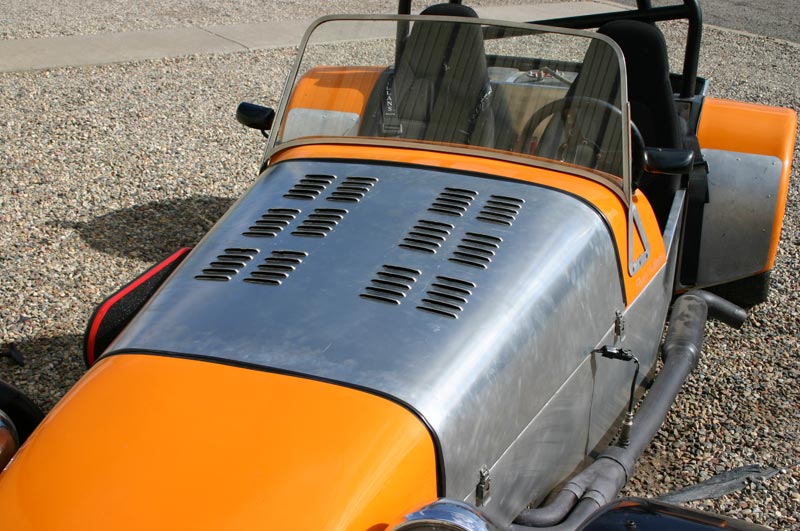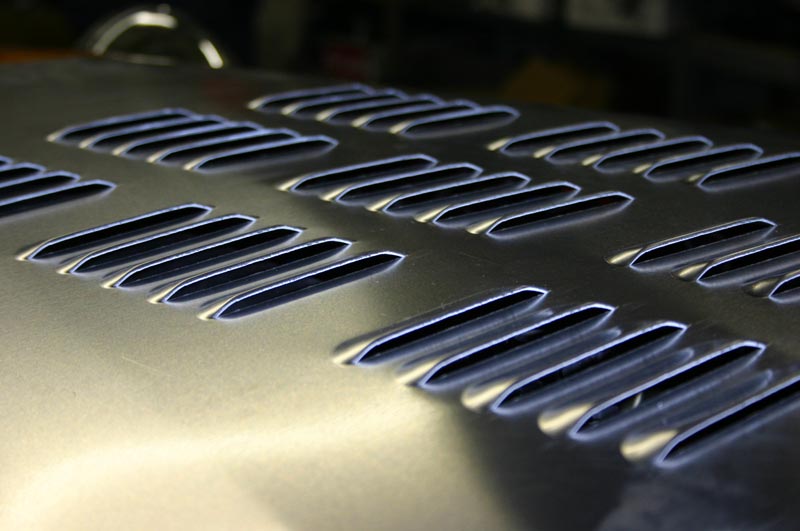
Mr_Asa
MegaDork
7/2/24 12:29 p.m.
Cause who wants to pay $300+ for one when they could sweat in the garage across three weekends?
I have a nice chunk of 3/4" plate im gonna cut up.
Basically gonna follow this guy's process. https://youtu.be/1f-VwmwKZIk?si=-eTi99eRUyzyaNcO
I'm more concerned with the clearances I will need. I want this to work on thin sheet steel. I figure if I slit the piece I'm working on it will form it nicely. So then it is a matter of allowing enough clearance for the steel to stretch and form.
Anyone have any tips or tricks for me?
please post lots of pics , we may need to make on too ,
what are you going to use for the punch ?

Mr_Asa
MegaDork
7/2/24 1:08 p.m.
Definitely gonna post pics.
Im gonna build it so it initially can go on your normal HF press. With upgrades to follow if necessary.
I actually just made a louver die at work recently. It's 3D printed ABS and so far is working on 12ga 5052 aluminum. It requires a slot cut first though, because most of a louver die force comes from punching through the metal. If you don't mind slicing a small slot with a cutoff disc or waterjet/lasers (sendcutsend...) then the plastic die works great. I found modeling the louvered sheetmetal to be tedious, but for the die I just Extrude->up to surface (of the final louvered shape) with no clearance.

JFW75
New Reader
7/2/24 1:50 p.m.
Going to second the 3D printed press parts. We use them for forming stove panels in 22 gauge to 10 gauge steel and stainless steel. Work great. Lots of walls, 6-10 depending on what we are using them for, and 50% infill with PLA.
The other challenge is alignment of the dies. Mine just goes in a hand-powered arbor press so I added alignment pins.



Mr_Asa
MegaDork
7/2/24 2:06 p.m.
In reply to maschinenbau :
I was concerned about alignment. Im planning on stamping series of louvers in a row, and even in columns, so its def gonna need to be something that can align without pins.

kb58
UltraDork
7/2/24 2:14 p.m.
Midlana required about 100 louvers in its engine cover. For me it was better to find "a guy" who had a real louver punch and charged $1 per. My garage is such that I don't have room for much and something that's only going to be used once, even less so.

Mr_Asa
MegaDork
7/2/24 3:03 p.m.
kb58 said:
Midlana required about 100 louvers in its engine cover. For me it was better to find "a guy" who had a real louver punch and charged $1 per. My garage is such that I don't have room for much and something that's only going to be used once, even less so.
Yes, but you had a plan. I am berking around
Mr_Asa said:
Yes, but you had a plan. I am berking around
The only difference between science and berkeleying around is writing it down.

kb58
UltraDork
7/2/24 6:48 p.m.
One solution might be to buy something a punch, use it, then immediately sell it. That can work really well depending what the tool is, though I admit that in the case of a louver punch, it could be pretty hard to sell. I'm trying to sell some fish pond filter equipment and it's not going well on Craigslist (I refuse to use social media sites).
(I should add that it all comes down to time vs money vs the "gitterdun" attitude. If you have the time, making something yourself can be very rewarding. I made my own exhaust headers and really enjoyed the process (can't imagine what it would have cost, paying someone else.)
kb58 said:
Midlana required about 100 louvers in its engine cover. For me it was better to find "a guy" who had a real louver punch and charged $1 per. My garage is such that I don't have room for much and something that's only going to be used once, even less so.
I had a guy punch louvers in the hood of my Locost as well. I don't recall the cost, but it was along the same lines. I seem to recall his punch had some sort of alignment setup that made it easy to do rows - the punch used the previous louver to locate the metal. I didn't see the process.

Problem is that he punched them backwards, so I had to make a new hood. That was not a happy time. I had a blank sheet of aluminum punched by a friend with access to a CNC fab shop and nice sharp dies. I still have the backwards one stuck on the wall of my shop.

I know where there is an English wheel that makes the one in the video look like it was made by Playskool...
42" throat if you want to adapt something to it.

kb58
UltraDork
7/3/24 6:14 p.m.
Keith Tanner said:
Problem is that he punched them backwards, so I had to make a new hood. That was not a happy time. I had a blank sheet of aluminum punched by a friend with access to a CNC fab shop and nice sharp dies. I still have the backwards one stuck on the wall of my shop.
I was about to say that they look backwards... but now I'm not sure. The purpose is to lower under-hood temperature, so the question is: is there lower pressure below the engine, or above the hood? If it's the former, having them face forward might actually work better. Of course, if it does and it's installed that way, it means hearing "hey those are backwards" about a million times... This ignores any issues about rain, since presumably that's not how your Seven is used.
In reply to kb58 :
The purpose is to pull air through the radiator, which means they have to be extractors. Underhood pressure is usually higher than pressure on the top of the hood. This particular car also had a hot transmission tunnel from the high pressure air underhood moving through the tunnel after being heated by the radiator, pulling more air through the radiator and exhausting it out through the hood would help that. It also keeps the hood from trying to lift off the car! And stiffens it and looks good. Intake air temps aren't a factor because the intake protrudes through the side of the hood.
The engine bay is waterproof enough that even driving without a hood doesn't really cause a problem.
Completely gratuitous shot of the final hood and the intake.





































